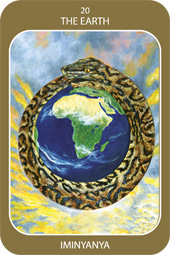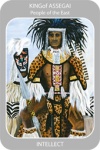 20 The Earth – IMINYANYA (The Ancestors)
20 The Earth – IMINYANYA (The Ancestors)
CONCEPT Good judgement; Rebirth; Introspection; Transformation; Evaluation; Metamorphosis
Iminyanya invites you to follow your destiny.
Reaping reward from past actions /Analysis and evaluation /Absolution /Responsibility /New view of reality /Making wise judgements /Integration /Wholeness /Ancestral and family matters /Avoidable influences
What is awakening? How are you renewed? Are you observing situations objectively and fairly?
The Ancestors: Iminyanya/amadlozi/badimo/vadzimo/abezimu – all these terms refer to those who have died and joined the spiritual world. In most African cultures, death is viewed not as the destruction of life but the immortality of the spirit.
24 September is a very busy day in South Africa – National Heritage Day, National Braai Day and also the day that commemorates the life of the great Zulu king Shaka. 
All South Africans are encouraged to celebrate their heritage, and that’s quite a melting pot in our Rainbow Nation. Our diversity of race, religion and creed are different, and its those differences we should celebrate and learn from. It’s those differences that make South Africa a country with so much potential – if we could all just stop moaning about what’s wrong and do something to make it right.
Reading some of the comments online about Heritage Day, it saddens me that so few people acknowledge and respect their heritage. Heritage is something that is passed down from generation to generation … and its not just about financial gain, it’s about the preservation of our land, scenic parks, animals, sites of significance or historical importance. It’s about preserving what we have for future generations benefit, pleasure and knowledge. This generation is failing. Our Rhino is almost extinct, global warming and toxic air is increasing, education levels are getting lower and lower. There is so much focus on the individual that the ‘whole’ is suffering.
Genetically speaking we are born into a predefined race and creed. This is affected not only by geography but also economic status. Throughout our lives we are able at any given point to change, alter and adjust our circumstances. Some choose to follow the patterns of the past, some choose to do nothing and wait for others, others choose to break free and set their own path.
Spring brings us an opportunity to awaken and be renewed. To look at our lives and carefully consider what is my heritage? To ask what can be changed or renewed. To take action to bring about those changes we seek. To take responsibility for those choices and actions. We need a new view on reality. It is what it is and not moving forward within ourselves limits our possibilities and opportunities. We should rejoice in the fact that we are able to make a difference. That we are able to take a stand for what we believe in.
The stages of our lives follow the same pattern of birth, childhood, maturing, adult and ultimately death. We need to look at each of those phases and ask “did I do the best I could”? As we grow up under the care of others, we inherit their views, ideals and philosophies. When we mature into creative and reproductive adults, we begin to form our own opinions and perhaps start our own traditions.
Have we chosen to live a good and righteous life? Are we truly doing the best we can to preserve our inheritance from our ancestors and how are we creating a better world for the future.
Death is unavoidable but one should not fear the end, rather be in a position that at any given moment when Death comes calling, we are free of attachments, regrets and that we have lived our best life. For when we are dead we become the ancestors to the living – what is your legacy?
What is your immortality of spirit?
iTongo legend
The snake is commonly found in African mythology and is regarded as immortal because it sheds its skin and continues to live. For the Zulu, the snake is a metamorphosed amalgam of the ancestors, who visit either in dreams or in reality. A snake that enters the house is unthreatening and is viewed as ‘family’ and as such is never harmed.
Ouroboros (tail-devourer), a snake depicted with its tail in its mouth forming a continuous circle, is considered a symbol of eternity. It is present in many African artworks – cloth patterns, wall paintings, and metal works.
According to legend, the snake carried the creator in his mouth while the earth was being created. The creator feared that the earth would sink into the sea beneath the weight of the mountains. The snake coiled itself around the earth, holding firm with its tail in its mouth; this hold must never be loosened, otherwise all of creation will disintegrate.
In order for African people to live in harmony with the creator and creation, all natural laws and observances were divinely revealed to the first African generation as a community at the beginning of time. The death of that generation meant the beginning of intercession between the living and the creator, or ancestor worship, as the first generation had now joined the spiritual world thereby marking the beginning of the ancestors.
Many African peoples regard the earth as a female deity, a mother-goddess who rules all people and is the mother of all creatures. The earth lives and gives birth to ever-new generations of beings and the ancestors live in the earth.
The earth’s elements: fire, air, and water are recognised as gifts from the great mother, yet the earth is seldom worshipped. Nevertheless, the earth has a very powerful spirit that rules over life and death.